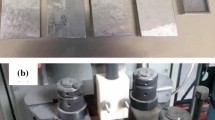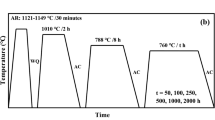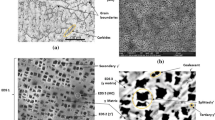Abstract
Driven by the need to reduce CO2 emissions from fossil power generation, new turbine working fluids are being investigated. One such fluid, supercritical carbon dioxide (sCO2), offers potential for improved energy conversion efficiency. In situ corrosion studies on precipitate-hardened nickel superalloys in sCO2 have shown potentially dangerous subsurface depletion of gamma prime phase. In the present work, the ex situ effect of supercritical fluid exposure on fatigue crack growth thresholds was measured for the Ni-based superalloy Haynes 282. After exposure of 500 h at 730 °C, there was a small measurable and repeatable reduction in fatigue thresholds at room temperature from 13 to 11 MPa√m after exposure. This reduction in fatigue crack growth threshold occurred irrespective of the exposure environment and was attributed to a decrease in roughness-induced crack closure.
Similar content being viewed by others

References
P.D. Jablonski et al., Processing of Advanced Cast Alloys for A-USC Steam Turbine Applications, JOM, 2012, 64(2), p 271–279
S. Park et al., Thermodynamic and Economic Investigation of Coal-Fired Power Plant Combined with Various Supercritical CO2 Brayton Power Cycle, Appl. Therm. Eng., 2018, 130, p 611–623
G.R. Holcomb, C. Carney, and Ö.N. Doğan, Oxidation of Alloys for Energy Applications in Supercritical CO2 and H2O, Corros. Sci., 2016, 109, p 22–35
Gordon R. Holcomb, Ö.N.D., Casey Carney, Kyle Rozman, Jeffrey A. Hawk, Mark H. Anderson. Materials performance in supercritical CO2 in comparison with atmospheric pressure CO2 and supercritical steam. in The 5th International Symposium - Supercritical CO2 Power Cycles. 2016. San Antonio, Texas.
R.P. Oleksak et al., High-Temperature Oxidation of Commercial Alloys in Supercritical CO2 and Related Power Cycle Environments, JOM, 2018, 70(8), p 1527–1534
L. Tan et al., Corrosion Behavior of Ni-Base Alloys for Advanced High Temperature Water-Cooled Nuclear Plants, Corros. Sci., 2008, 50(11), p 3056–3062
R. Knödler and S. Straub, Steam Oxidation of Martensitic Steels and of Ni-Base Alloys: Comparison of Lab Tests with Operating Power Plants, Oxid. Met., 2014, 82(1), p 113–122
B.A. Pint, R.G. Brese, and J.R. Keiser, Effect of Pressure on Supercritical CO2 Compatibility of Structural Alloys at 750 °C, Mater. Corros., 2017, 68(2), p 151–158
A. Thatte, E. Martin, T. Hanlon, A Novel Experimental Method for LCF Measurement of Nickel Base Superalloys in High Pressure High Temperature Supercritical CO2, in Proceedings of ASME Turbo Expo 2017: Turbomachinery Technical Conference and Exposition (Charlotte, NC, 2017)
J. Saarimäki, J.J. Moverare, and M.H. Colliander, Time- and Cycle-Dependent Crack Propagation In Haynes 282, Mater. Sci. Eng. A, 2016, 658, p 463–471
S. Ismonov et al., Application of Crack Tip Plasticity Based Fatigue Model on High Temperature Alloy HAYNES® 282®, Int. J. Fatigue, 2015, 70, p 146–153
K.A. Rozman, J.J. Kruzic, and J.A. Hawk, Fatigue Crack Growth Behavior of Nickel-base Superalloy Haynes 282 at 550-750°C, J. Mater. Eng. Perform., 2015, 24(8), p 2841–2846
K.A. Rozman et al., Fatigue Crack Growth Mechanisms for Nickel-based Superalloy Haynes 282 at 550-750°C, J. Mater. Eng. Perform., 2015, 24(10), p 3699–3707
L.M. Pike, Haynes 282 Alloy—A New Wrought Superalloy Designed for Improved Creep Strength and Fabricability, in ASME Turbo Expo 2006: Power for Land, Sea, and Air (Barcelona, Spain, 2006)
R.A. Buckson and O.A. Ojo, Cyclic Deformation Characteristics and Fatigue Crack Growth Behaviour of a Newly Developed Aerospace Superalloy Haynes 282, Mater. Sci. Eng. A, 2012, 555, p 63–70
K.A. Rozman, Characterization of High Temperature Fatigue Mechanisms in Haynes 282 Nickel Based Superalloy, in Materials Science (Oregon State University, 2014)
J.A. Hawk et al., Gamma Prime Stability in Haynes 282: Theoretical and Experimental Considerations, J. Mater. Eng. Perform., 2015, 24(11), p 4171–4181
International, A., ASTM E647-15e1, Standard Test Method for Measurement of Fatigue Crack Growth Rates (West Conshohocken, PA, 2015)
K.A. Rozman, Characterization of High Temperature Fatigue Mechanisms in Haynes 282 Nickel Based Superalloy, Ph.D thesis, Oregon State University, Corvallis, OR, 2014. https://ir.library.oregonstate.edu/concern/graduate_thesis_or_dissertations/tt44pr195
D.C. Maxwell, Method for Determining Crack Length for a C(T) Specimen, University of Dayton Research Institute, Dayton, 1987
International, A., ASTM E407-07(2015)e1, Standard Practice for Microetching Metals and Alloys (West Conshohocken, PA, 2015)
International, A., ASTM E112-13, Standard Test Methods for Determining Average Grain Size (West Conshohocken, PA, 2013)
S. Suresh, Ed., Fatigue of Materials, 2nd ed., Cambridge University Press, New York, 1998
International, A., ASTM B909-17, Standard Guide for Plane Strain Fracture Toughness Testing of Non-Stress Relieved Aluminum Products (West Conshohocken, PA, 2017)
R.W. Bush, J.K. Donald, R.J. Bucci, Pitfalls to avoid in threshold testing and its interpretation, in Fatigue Crack Growth Thresholds, Endurance Limits, and Design, edited by J. Newman, R. Piascik (ASTM International: West Conshohocken, PA, 2000)
Y.-N. Du et al., Effect of Long-Term Aging on Near-Threshold Fatigue Crack Growth of Ni-Cr-Mo-V Steel Welds, J. Mater. Process. Technol., 2015, 226, p 228–237
S. Gao et al., Microstructural Evolution and Mechanical Properties of Solution Annealed Cast IN617B Alloy During Long-Term Thermal Exposure, Mater. Sci. Eng. A, 2017, 704, p 302–310
F.F. Han et al., Effect of Long-Term Thermal Exposure on the Hot Ductility Behavior of GH3535 Alloy, Mater. Sci. Eng. A, 2016, 673, p 299–306
C. Wang et al., Microstructural Changes and Their Effect on Tensile Properties of a Ni-Fe Based Alloy During Long-Term Thermal Exposure, Mater. Sci. Eng. A, 2016, 670, p 178–187
L. Lawson, E.Y. Chen, and M. Meshii, Near-Threshold Fatigue: A Review, Int. J. Fatigue, 1999, 21, p S15–S34
R.O. Ritchie, Mechanisms of Fatigue-Crack Propagation in Ductile and Brittle Solids, Int. J. Fract., 1999, 100(1), p 55–83
S. Ishihara, Y. Sugai, and A.J. McEvily, On the Distinction Between Plasticity- and Roughness-Induced Fatigue Crack Closure, Metall. Mater. Trans. A, 2012, 43(9), p 3086–3096
International, A., ASTM E399-17, Standard Test Method for Linear-Elastic Plane-Strain Fracture Toughness KIc of Metallic Materials (West Conshohocken, PA, 2017)
S. Suresh and R.O. Ritchie, A Geometric Model for Fatigue Crack Closure Induced by Fracture Surface Roughness, Metall. Trans. A, 1982, 13(9), p 1627–1631
C. Shen, Modeling Long-term Creep Performance for Welded Nickel-base Superalloy Structures for Power Generation Systems, GE Global Research, Niskayuna, 2015
Acknowledgment
This work was performed in support of the US Department of Energy’s Fossil Energy Crosscutting Technology Research Program. The research was executed through the NETL Research and Innovation Center’s Advanced Alloy Development Field Work Proposal. Research performed by Leidos Research Support Team (LRST) staff was conducted under the RSS Contract 89243318CFE000003.
Author information
Authors and Affiliations
Corresponding author
Additional information
Publisher's Note
Springer Nature remains neutral with regard to jurisdictional claims in published maps and institutional affiliations.
Disclaimer: This work was funded by the Department of Energy, National Energy Technology Laboratory, an agency of the United States Government, through a support contract with LRST. Neither the United States Government nor any agency thereof, nor any of their employees, nor LRST, nor any of their employees, makes any warranty, expressed or implied, or assumes any legal liability or responsibility for the accuracy, completeness, or usefulness of any information, apparatus, product, or process disclosed, or represents that its use would not infringe privately owned rights. Reference herein to any specific commercial product, process, or service by trade name, trademark, manufacturer, or otherwise, does not necessarily constitute or imply its endorsement, recommendation, or favoring by the United States Government or any agency thereof. The views and opinions of authors expressed herein do not necessarily state or reflect those of the United States Government or any agency thereof.
Rights and permissions
About this article
Cite this article
Rozman, K.A., Holcomb, G.R., Carney, C.S. et al. Effect of 730 °C Supercritical Fluid Exposure on the Fatigue Threshold of Ni-Based Superalloy Haynes 282. J. of Materi Eng and Perform 28, 4335–4347 (2019). https://doi.org/10.1007/s11665-019-04164-2
Received:
Published:
Issue Date:
DOI: https://doi.org/10.1007/s11665-019-04164-2














